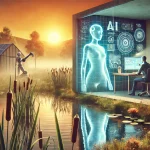
The Environmental Price Tag of AI: Finding the Green Balance
As AI reshapes our digital world, it's also leaving a significant environmental footprint. By 2030, AI systems are projected to demand 14 gigawatts of additional power—equivalent to a small nation's electricity needs.
The numbers are sobering: training ChatGPT alone generates approximately 8.4 tons of CO2 emissions, comparable to two American households' annual carbon footprint. U.S. data center energy consumption is expected to jump from 200 TWh in 2022 to 260 TWh by 2026—about 1.6 times New York City's total electricity usage.
This growing energy demand affects everyone, potentially leading to higher electricity costs, strained power grids, and slower adoption of clean energy technologies.
Fortunately, industry leaders are taking action. Google is optimizing data center cooling with AI, Microsoft aims to be carbon-negative by 2030, and Alibaba Cloud has committed to 100% clean energy by 2030.
Practical strategies for sustainable AI include:
- Transitioning data centers to renewable energy sources
- Developing energy-efficient AI models (smaller, specialized models often work just as well)
- Implementing carbon emissions tracking
- Adopting circular economy approaches for AI hardware
Despite challenges, sustainable AI offers substantial economic benefits. The green technology and sustainability market, boosted by AI solutions, is projected to reach $73.9 billion by 2030.
The path forward requires balancing innovation with environmental responsibility. By prioritizing sustainability alongside technological advancement, we can ensure AI benefits humanity without compromising our planet.
Learn more in Oliver's comprehensive analysis: The Hidden Cost of Innovation: Balancing AI Development with Environmental Sustainability
Is your organization considering the environmental impact of its AI initiatives? What steps are you taking to make AI more sustainable?
If you found this valuable, please share it with colleagues concerned about sustainable technology.


